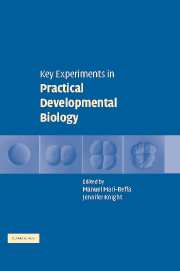Book contents
- Frontmatter
- Contents
- List of contributors
- Preface
- Introduction
- SECTION I GRAFTINGS
- 1 Two developmental gradients control head formation in hydra
- 2 Embryonic regulation and induction in sea urchin development
- 3 The isthmic organizer and brain regionalization in chick embryos
- SECTION II SPECIFIC CHEMICAL REAGENTS
- SECTION III BEAD IMPLANTATION
- SECTION IV NUCLEIC ACID INJECTIONS
- SECTION V GENETIC ANALYSIS
- SECTION VI CLONAL ANALYSIS
- SECTION VII IN SITU HYBRIDIZATION
- SECTION VIII TRANSGENIC ORGANISMS
- SECTION IX VERTEBRATE CLONING
- SECTION X CELL CULTURE
- SECTION XI EVO–DEVO STUDIES
- SECTION XII COMPUTATIONAL MODELLING
- Appendix 1 Abbreviations
- Appendix 2 Suppliers
- Index
- Plate Section
- References
3 - The isthmic organizer and brain regionalization in chick embryos
Published online by Cambridge University Press: 11 August 2009
- Frontmatter
- Contents
- List of contributors
- Preface
- Introduction
- SECTION I GRAFTINGS
- 1 Two developmental gradients control head formation in hydra
- 2 Embryonic regulation and induction in sea urchin development
- 3 The isthmic organizer and brain regionalization in chick embryos
- SECTION II SPECIFIC CHEMICAL REAGENTS
- SECTION III BEAD IMPLANTATION
- SECTION IV NUCLEIC ACID INJECTIONS
- SECTION V GENETIC ANALYSIS
- SECTION VI CLONAL ANALYSIS
- SECTION VII IN SITU HYBRIDIZATION
- SECTION VIII TRANSGENIC ORGANISMS
- SECTION IX VERTEBRATE CLONING
- SECTION X CELL CULTURE
- SECTION XI EVO–DEVO STUDIES
- SECTION XII COMPUTATIONAL MODELLING
- Appendix 1 Abbreviations
- Appendix 2 Suppliers
- Index
- Plate Section
- References
Summary
OBJECTIVE OF THE EXPERIMENT The aim of the experimental techniques detailed here is to study the process of regionalization and histogenesis of specific areas in the vertebrate brain at early stages of development, using the chick embryo as an experimental model. We will deal with the morphogenetic properties of particular areas of the neural tube known as “secondary organizers.” We will then describe the quail–chick chimaera system developed by Le Douarin (1973) in the discovery and analysis of the isthmic organizer (IsO). This in ovo system has the particular advantage of accessibility to the developing embryo: it is easy and relatively cheap, and the embryo can be monitored for a relatively long period of time as it develops. On the contrary, mouse embryo models, now extensively used in the functional genetic analysis of development, lack these features.
DEGREE OF DIFFICULTY This project is difficult. Experimental embryology requires some experience with vertebrate embryos and knowledge of neuroanatomy. These experiments also demand skillful manipulation and relatively sterile conditions.
INTRODUCTION
The central nervous system is composed of defined neuronal structures interconnected by a complex network of nerve fibers. The potential to construct this complexity is contained in the primary neural anlage: the neural plate. This pseudostratified neuroepithelium, produced during gastrulation, undergoes the process of neurulation by which the neural plate folds and is converted into the neural tube.
- Type
- Chapter
- Information
- Key Experiments in Practical Developmental Biology , pp. 37 - 49Publisher: Cambridge University PressPrint publication year: 2005



